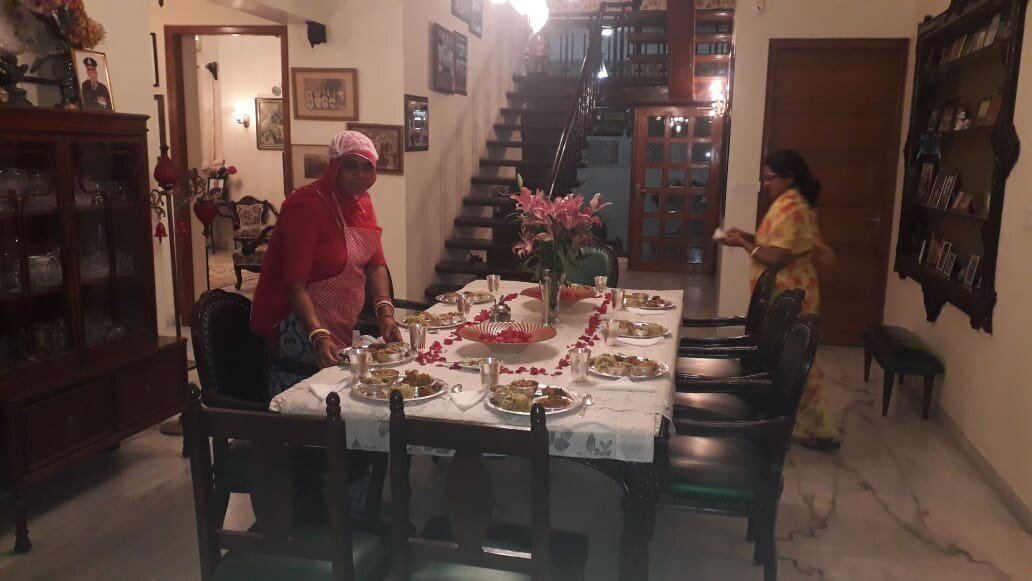Dera Jaipur: Reviving Old Cuisines, By Rekha Rani Singh

The past as it turns out makes a great future sense. Today every well-known Indian dish is the product of a long history of invasion and the fusion of different food traditions. Culinary knowledge in India was not limited to cooking techniques, but also included concerns for health and nutrition. This link between food, pleasure and health has been around for a long time, as attested by old recipes. The only thing more indecipherable than the untidy scrawl in which the recipes are written are the instructions themselves. Weights and measures are in ancient standards of ‘Tolas’, ‘Chataks’ and ‘Seer’.
Our Rajput history is complete with brave tales of our heroes but with little browsing, you will see that some of them were chefs par excellence. In our mythology, the Pandavas were skillful in culinary arts. Bhim lived as a cook in Virata’s kitchen during their exile.
Rajput history is replete with tradition of hunting and meat eating. Game cooking was unique in the Rajasthan region. It varied from partridges, pheasants, fowls, wild boar to antelopes. Wild rabbits were always a delicacy during summer months as they supposedly prevented typhoid. Today wild rabbits are being bred for consumption. On demand from our guests at Dera Jaipur, we cook locally bred quails too.
Many delicacies like ‘Khad’ and ‘Mokul’ are not lost. Mokul is the dish with shredded rabbit cooked with the famous ‘Mathaniya’ chillies. For our guests at Dera Jaipur we make it with chicken too. Mathaniya chillies are from the desert with a fiery red colour and sweet pungency. These chillies impart a unique flavor to the food and also hide the smell from the regular or game meat.
‘Khad’ again is the native Rajput way of cooking whole rabbit smeared with spices and a particular local vegetable called ‘Kachri’, which is wrapped in wheat bread called ‘Rotis’ smeared with ghee (clarified butter). This again is wrapped in banana leaves and tied in a jute bag which is buried in the ground with burning coal or wood and then sealed with mud. It is then left to cook for about two hours.
Lip smacking ‘Junglee Maas’ is made with five ingredients: garlic, chillies, yogurt, ghee and salt, as these are always available during a hunt or war. We replicate for our discerning guests with chicken and mutton too.
Old recipes talk of various kinds of grains. Arid desert produces Pearl millet called ‘Bajra’. Porridge called ‘Khitchra’ cooked with lentils and Bajra is an unusual dish served with spiced buttermilk gravy called ‘Khata’. This Khitchra when cooked with ‘Laal Maas’ is the famous dish called ‘Soyeta’. It is our signature dish at Dera Jaipur.
Laal Maas. Picture Credit, Rekha Rani Singh
Vegetarian dishes are unique with the art of ‘Dhungar’ that is smoking the food with burning coal placed in the center with one clove and a dollop of ghee poured over it and then covered with a tight lid. Since there was paucity of green vegetables in the desert, they supplemented the iron content in the food with a berry called ‘Ker’ and beans that grow in the desert called ‘Sangri’. Ker Sangri is a delicacy of Rajasthan.
Ker Sangri.
Picture Credit: Rekha Rani Singh
In the warm climate of Rajasthan, pastoralism is the fundamental subsistence for food. Positive and subtle effects of the ‘Ghee’ is said to come from the fact that it comes freely from the cow. Free grazing cows eat all kinds of rare herbs, indigenous plants and grass. Milk from such cows therefore contains the essence of all those energies and ghee is the essence of the milk.
In the desert where stomach bugs were easy to pick up, yoghurt acted as an ancient antibiotic. That is why it is rarely heated and eaten at room temperature. According to ancient Ayurveda, yoghurt when churned into buttermilk undergoes ‘Manthan Sanskar’ and become sweet after digestion, which has a cooling effect. Our ancient sutras proclaim : “Just as nectar is for Gods , buttermilk is for humans.”
Rajasthani ‘Bajre Ki Rabri’ is a traditional beverage for the summer months to combat hot weather. It is made with buttermilk, bajra flour and cumin. The extensive use of other indigenous grains like ‘Jau’ and ‘Makka’ is very popular in Rajasthan. There are numerous kinds of breads that are made with different kinds of grains. The most unusual bread is the ‘Maas Ki Roti’ i.e., a thick roti made with ground mutton.
The Traditional Thali at Dera Jaipur.
Picture Credit: Rekha Rani Singh
Food can feed the mind, body and soul only if it is ethically sourced. On our farm we are adhering to strict organic rules. Hence, we source our food for our guests from our organic cultivation. Every great dream begins with a dreamer, as dreams create passion which is filled with patience and strength. Post my husband’s retirement we moved to Jaipur, our hometown. That is when Dera Jaipur, my boutique home stay was conceptualized. One reason many dreams never go anywhere is because the dreamer keeps it all to himself. Dera Jaipur started in Oct 2019 with an all women team. It is my passion to help women to overcome challenges such as ‘Life burnout’. Motto at Dera Jaipur is to hire local women staff thereby helping them to create a better life.






